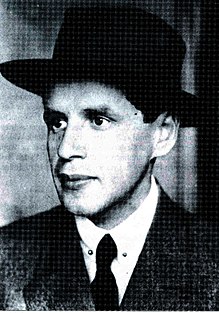Lasar Segall
Lasar Segall (born July 21, 1891 in Vilnius ; died August 2, 1957 in São Paulo ) was a Brazilian painter , graphic artist and sculptor of the Jewish faith .
Live and act
Lasar was born the sixth of eight children of Esther Ghodes Glaser Segall and Abel Segall in the Jewish quarter of Vilna. At fourteen he attended the drawing school in Wilna, at fifteen he went to Berlin, where he continued his studies at the Royal Academy of Arts . In 1910 he went to the Dresden Art Academy as a master class student , where he completed his studies. From 1912 to 1913 he made his first trip to Brazil, where he visited his siblings Oscar, Jacob and Luba. At the end of 1913 he returned to Germany, where he married Margarete Quack in 1918.
In 1919 he founded the Dresden Secession with artist friends and colleagues such as Otto Dix , Conrad Felixmüller , Wilhelm Heckrott , Otto Lange , Constantin von Mitschke-Collande , Peter August Böckstiegel , Otto Schubert , Gela Forster and Hugo Zehder . Many exhibitions and trips in Europe followed. In 1924 he separated from Margarete Quack and returned to Brazil. In 1932 he was co-founder of the Sociedade Pró-Arte Moderna (SPAM) . Further exhibitions in Europe and Brazil followed. In Germany he was one of the ostracized artists in the 1937 exhibition “ Degenerate Art ” organized by the National Socialists in Munich.
Since the mid-thirties, Segall dealt with the universal themes of war, extermination and emigration: in 1937 he painted the painting Pogrom (Museu Lasar Segall, São Paulo), followed by war (1942, Museu Lasar Segall, São Paulo) , Concentration Camp (1945, private collection) and Exodus (1947, Jewish Museum, New York City ). The key image of this series of contemporary works is the painting Navio de emigrantes (1941, Museu Lasar Segall, São Paulo).
In 1955 he was given his own room on III. Biennale for Modern Art in São Paulo honored. Lasar Segall died on August 2, 1957 at the age of 66 in São Paulo.
The Lasar Segall Museum opened in São Paulo on September 21, 1967 .
style
The subject of his paintings was the human being in relation to other people and to God, whereby his pictures increased "in religious power". He painted “beggars, starving, emigrants, persecuted Jews, exhausted from work, sick people in the doctor's waiting room and dying”. The main emphasis on his style is the intensity and religious power. He worked with "the greatest intensity of expression and with renunciation strokes and colors". In doing so, he "with ascetic tenacity renounced any dispensable means of color and form".
literature
- Kerstin Hagemeyer: Jewish life in Dresden. Exhibition on the occasion of the consecration of the new Dresden synagogue on November 9, 2001 . Saxon State Library - Dresden State and University Library, Berlin 2002, ISBN 3-910005-27-6 , p. 170 to 171 .
- PM Bardi, Lasar Segall: Musée d'Art de São Paulo, Brésil , 2nd éd. - Milano: Ed. del Milione, 1959
- Martin Schieder: The crossing as a metaphor of existence. On the Navio de emigrantes by Lasar Segall, in: Art topographies of global migration: Places and spaces of transitory art experience (Critical reports, 2/2015), ed. by Burcu Dogramaci, Birgit Mersmann, Anna Minta and Mona Schieren, pp. 39–49.
Web links
- Literature by and about Lasar Segall in the catalog of the German National Library
- Museu Lasar Segall in São Paulo
- Lasar Segall in the Enciclopédia Itaú Cultural (Brazilian Portuguese)
- Lasar Segall , Internationales Biographisches Archiv 21/1960 from May 16, 1960, in the Munzinger archive ( beginning of article freely accessible)
Individual evidence
- ↑ Graziela Naclerio Forte "CAM e SPAM: Arte, Política e Sociabilidade na São Paulo Moderna, do Início dos Anos 1930" page 47; São Paulo 2008 (Portuguese)
- ↑ a b c d Hagemeyer, p. 170 (8.3 Lasar Segall catalog, with contributions by Theodor Däubler and Will Grohmann, Dresden 1921, SLUB: IB 8690)
| personal data | |
|---|---|
| SURNAME | Segall, Lasar |
| ALTERNATIVE NAMES | Segal, Lasar |
| BRIEF DESCRIPTION | Brazilian painter, printmaker and sculptor |
| DATE OF BIRTH | July 21, 1891 |
| PLACE OF BIRTH | Vilna |
| DATE OF DEATH | 2nd August 1957 |
| Place of death | São Paulo |
